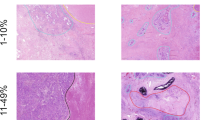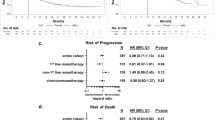Abstract
The data of 766 patients participating in three German multicentre trials were analysed with regard to the relationship between baseline characteristics and prognosis in small cell lung cancer (SCLC). The central aim of this analysis has been to evaluate the role of gender as an independent prognostic factor in SCLC. The minimum follow-up period for the 652 male and 114 female patients was 36 months. Female patients were shown to have a higher complete remission rate (35% vs 25%), a superior median survival (ms) (12.1 months (mo) vs 9.8 mo), and a favourable 2-year survival rate (2ys) (19% vs 8%) to male ones. Various other prognostic factors have been proved to be significant, such as extent of disease, clinical performance status, and history of smoking, whereas weight loss prior to chemotherapy and age have been less important factors. We have been able to ascertain that women's responses were better than those of male patients independent of any other relevant prognostic variable. Furthermore, results were found to be even more advantageous for female patients with additional favourable prognostic parameters, i.e. for patients with limited disease (ms 15.2 mo vs 12.0 mo; 2ys 29% vs 9%) or with good performance status (ms 13.4 mo vs 10.4 mo; 2ys 24% vs 7%). A most remarkable observation was made in that the favourable prognostic effect of the female gender was restricted to patients aged less than 60 years (ms 13.3 mo vs 10.1 mo; 2ys 26% vs 5%), whereas for older women no advantages over men's results were established (ms 9.3 ml vs 9.1 mo; 2ys 8% vs 7%). A proportion of 32% of female patients with limited disease aged less than 60 years achieved a 3-year survival rate. We conclude (a) that sex constitutes a major prognostic factor in SCLC and is especially useful as a predictor for long-term survival, and (b) that the favourable prognostic value of the female sex is restricted to younger patients.
This is a preview of subscription content, access via your institution
Access options
Subscribe to this journal
Receive 24 print issues and online access
$259.00 per year
only $10.79 per issue
Buy this article
- Purchase on Springer Link
- Instant access to full article PDF
Prices may be subject to local taxes which are calculated during checkout
Similar content being viewed by others
Author information
Authors and Affiliations
Rights and permissions
About this article
Cite this article
Wolf, M., Holle, R., Hans, K. et al. Analysis of prognostic factors in 766 patients with small cell lung cancer (SCLC): The role of sex as a predictor for survival. Br J Cancer 63, 986–992 (1991). https://doi.org/10.1038/bjc.1991.215
Issue Date:
DOI: https://doi.org/10.1038/bjc.1991.215
This article is cited by
-
Long-term survival data of patients with limited disease small cell lung cancer: a retrospective analysis
Investigational New Drugs (2022)
-
Development and validation of a prognostic model of resectable small-cell lung cancer: a large population-based cohort study and external validation
Journal of Translational Medicine (2020)
-
Insulinoma-associated protein 1 (INSM1): a potential biomarker and therapeutic target for neuroendocrine tumors
Cellular Oncology (2020)
-
Prognostic role of patient gender in limited-disease small-cell lung cancer treated with chemoradiotherapy
Strahlentherapie und Onkologie (2017)
-
Ectopic expression of a small cell lung cancer transcription factor, INSM1 impairs alveologenesis in lung development
BMC Pulmonary Medicine (2016)



